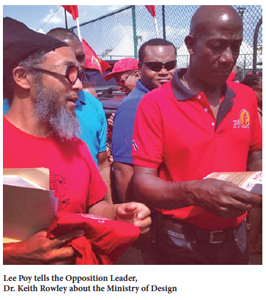 |
 |
 |
|
July 2015 |
However, regardless of genre, all innovative and competitive products turn on the element of design, which is then supported by relevant research and development but it is this key – design that is generally considered to be the genesis of innovation and competiveness. Research suggests that design has a significant positive effect on the economies of countries by making industries more competitive, by stimulating manufacturing as a tool for social development and even by addressing issues to improve infrastructure for health, crime prevention, education and transport systems. Every Carnival season in an ever increasing number of ways and for at least the last one hundreds of its years of history, the nation of Trinidad and Tobago proves to the world that its capacity for design is incomparable; yet there is no formally organized institution or system that is aimed at nurturing and harnessing this socially and economically all important skill. How can this be addressed? This question is the one that was taken up by the Department of Creative and Festival Arts (DCFA) at The UWI, St. Augustine campus, at its recent two-day colloquium. Titled, Ministry of Design – from cottage industry to state enterprise, the colloquium explored the general public perception that design relates primarily to fashion, graphic design and Carnival. Currently, Trinidad and Tobago has neither design policies nor programmes to incubate or facilitate design although there is an avowed focus on innovation and competitiveness. Colloquium chairs Lesley-Ann Noel and Michael Lee Poy guided the process over the two days and encouraged debate on the possible outcomes should the government of Trinidad and Tobago direct substantial financial investment towards design initiatives on a national level. The sessions were governed by the enquiry: How could a ‘Ministry of Design’ encourage and stimulate design and create awareness of its importance among individuals, families, educators, business and non-governmental organisations?
Robert Pulley of the Royal College of Art in London proposed in his paper that a Ministry of Design in Trinidad and Tobago could facilitate inspiring collaborations between students, academics and entrepreneurs, with the Visual Arts Unit of the DCFA playing a leading role in these collaborations and in promoting learning through making. He suggested that an international research centre for design, education and enterprise as a joint venture of the UWI and the government of Trinidad and Tobago, as a main project of launching a Ministry of Design. Several other valid suggestions on how the Ministry could function, and what projects it could undertake were made in other papers and in the Q&A sessions of the colloquium. Full papers will be available for digital distribution by the end of June. (Interested persons can contact dcfa@sta.uwi.edu to be added to the MOD mailing list) The Ministry of Design colloquium, was just the first step in a series of initiatives that will be needed to sensitise both the public and policymakers about the value and impact of design. The chairs of the colloquium have the long-term aspiration of developing a Caribbean Design Research Institute that will produce real time data on the benefits and impact of design, and support the creation and implementation of regional design and innovation policies and action plans. A wide range of photos from the event is available at: https://www.facebook.com/pages/Unofficial-Ministry-of-Design-Trinidad-and-Tobago/1604002036523307 Lesley-Ann Noel is a lecturer in Design at UWI and a PhD candidate at the North Carolina State University.Michael Lee Poy is a part time lecturer, designer, artist and registered and practicing architect in Trinidad and Tobago. |


 Innovation is the key to competitiveness. This rhetorical sounding truism is timelessly relevant for a reason – the fact that commercially successful products are so because they have found a way to conceptually and practically reinvent, sometime repurpose a largely familiar system into new, cannot-live-without products. Just in this contemporary time, the nexus of innovation and market brings to mind smartphones, any portable computer devise, moisture-repelling fabric, the hybrid car, super-light footwear, action cameras like the go-pro, wireless devices such as headsets, keyboards, the computer mouse, and so many more.
Innovation is the key to competitiveness. This rhetorical sounding truism is timelessly relevant for a reason – the fact that commercially successful products are so because they have found a way to conceptually and practically reinvent, sometime repurpose a largely familiar system into new, cannot-live-without products. Just in this contemporary time, the nexus of innovation and market brings to mind smartphones, any portable computer devise, moisture-repelling fabric, the hybrid car, super-light footwear, action cameras like the go-pro, wireless devices such as headsets, keyboards, the computer mouse, and so many more.  The colloquium was arranged around a hypothetical existence of the ‘Ministry of Design’, complete with a coat of arms, designed by Level 2 Visual Arts student Melissa Miller, and with a motto in Latin: cognitans a melior Trinidad et Tobago, which translates to ‘designing a better Trinidad and Tobago. Memorabilia for the ‘Ministry’ was produced in-house. The co-chairs Noel and Lee Poy then ‘campaigned’ for this Ministry to political candidates, government officials and public figures, in a bold move to create public awareness about design. See adjacent photos that captured Lee Poy walking the talk to current names in the political arena.
The colloquium was arranged around a hypothetical existence of the ‘Ministry of Design’, complete with a coat of arms, designed by Level 2 Visual Arts student Melissa Miller, and with a motto in Latin: cognitans a melior Trinidad et Tobago, which translates to ‘designing a better Trinidad and Tobago. Memorabilia for the ‘Ministry’ was produced in-house. The co-chairs Noel and Lee Poy then ‘campaigned’ for this Ministry to political candidates, government officials and public figures, in a bold move to create public awareness about design. See adjacent photos that captured Lee Poy walking the talk to current names in the political arena.